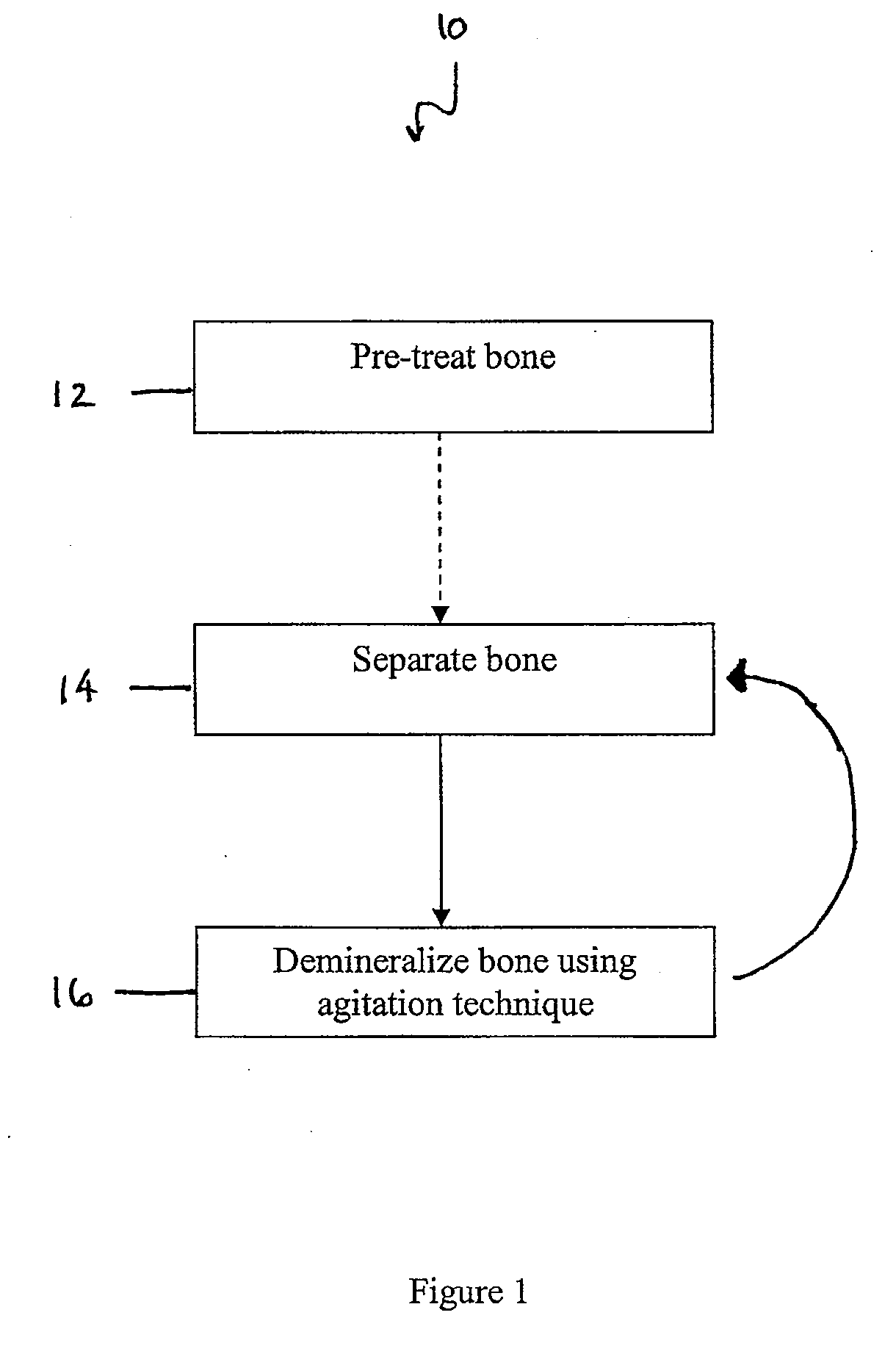Bone matrix compositions and methods
a bone matrix and composition technology, applied in the field of bone matrix compositions and methods, can solve the problems of affecting the potential of bone graft biological activity, reluctance to harvest, and insufficient amounts of acb for harvesting, so as to maintain the biological activity of bone, increase the yield of bone produced, and save time
- Summary
- Abstract
- Description
- Claims
- Application Information
AI Technical Summary
Benefits of technology
Problems solved by technology
Method used
Image
Examples
example 1
[0120]Several demineralization techniques were used and the rate of demineralization compared.
[0121]In a first technique, for comparison purposes, a human allograft bone shaft was demineralized using standard techniques. The bone was cut into 2-5 mm thick strips using a band saw. Twenty grams (20 g) of bone strips were soaked in 300 ml 0.6N HCl solution with 0.075 ml Triton X100 with stirring. After 2.5 hours, a fresh 300 ml 0.6N HCl solution was replaced and the demineralization was continued for additional 60-72 hours. The completion of demineralization was confirmed with X-ray imaging. After imaging, the demineralized bone strips were rinsed with deionized water three times and were pressed into fibers using a carver press under a pressure of 4000-5000 psi. Demineralized bone fibers were collected between a 0.5 mm and a 4.0 mm sieve for further processing. The total demineralization time for this technique was about 62.5-74.5 hours with 2 acid soaks.
[0122]In a second technique, h...
example 2
[0125]This example examined the relationship between outgassing during vacuum demineralization (as described in Example 1) and the calcium content of the resulting demineralized bone fibers.
[0126]Human allograft bone shaft was cut into 2-5 mm thick by 20 mm, 30 mm, and 40 mm long strips using a band saw. Resulting bone strips were weighed ((13.53-13.65 g), and then soaked in approximately 136.5 ml 0.6N HCl under vacuum while outgassing from bone was monitored. After 5 minutes, vacuum was released and bone strips pressed with grooved plates, then returned to the reactor along with the same volume of fresh acid. This step was repeated once, after which the acid was changed and about 0.14 ml 25% Triton was added. After about 5 minutes without vacuum, the bone strips were removed and pressed with grooved plates. The bone strips were placed back in the reactor and the reaction was continued with vacuum for cycles of: 5 minutes in vacuum, press with flat plates; 5 minutes in vacuum, press...
example 3
[0128]This example looked at centrifuge demineralization. A human allograft bone shaft was cut into 2-5 mm thick strips using a band saw. The total mass of strips was divided into 4 buckets. The buckets were 2.5 liter and included a custom fixture for sitting the bone strips above the bottom of the bucket. The buckets were closed and placed into a centrifuge (Beckman-Coulter Model J-HC with JS-5.0 Rotor) and the centrifuge for a 10 minute cycle at 7380×G. At the completion of the cycle, lipids from the bone were removed from the bottom of the bucket. The strips were placed in clean buckets (without fixtures) using enough acid to meet a 300 ml 0.6N HCl solution with 0.075 ml Triton X100 for every 20 g of bone strips. The buckets were closed and placed into the centrifuge for a 20 minute cycle at 7380×G. The bone strips were transferred back to buckets having fixtures. The buckets were closed and placed into the centrifuge for a 15 minute cycle at 7380×G. The bone strips and fixtures ...
PUM
 Login to View More
Login to View More Abstract
Description
Claims
Application Information
 Login to View More
Login to View More - R&D
- Intellectual Property
- Life Sciences
- Materials
- Tech Scout
- Unparalleled Data Quality
- Higher Quality Content
- 60% Fewer Hallucinations
Browse by: Latest US Patents, China's latest patents, Technical Efficacy Thesaurus, Application Domain, Technology Topic, Popular Technical Reports.
© 2025 PatSnap. All rights reserved.Legal|Privacy policy|Modern Slavery Act Transparency Statement|Sitemap|About US| Contact US: help@patsnap.com

